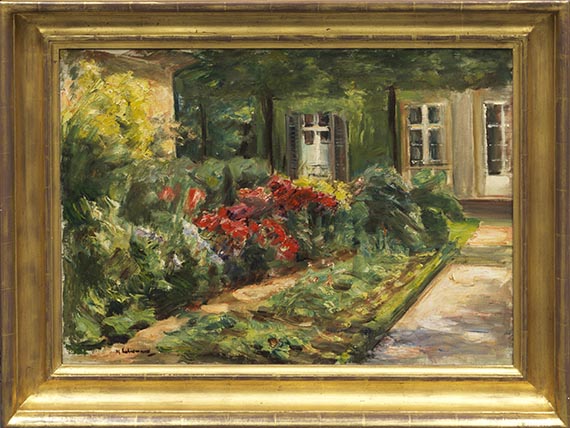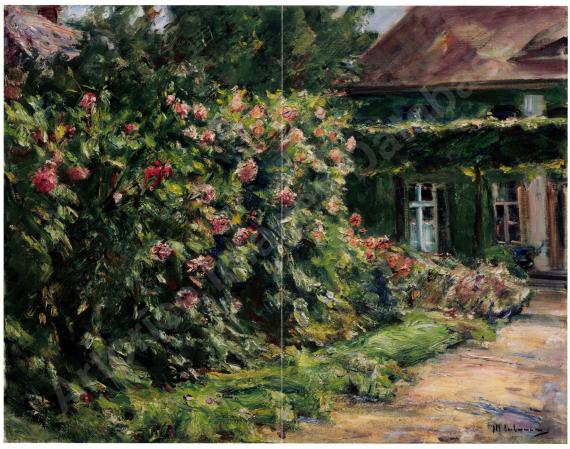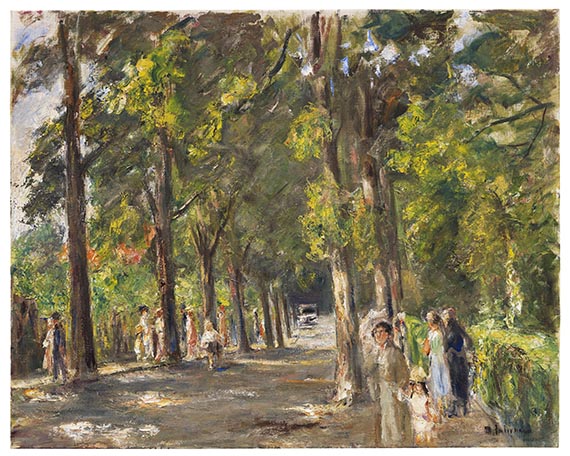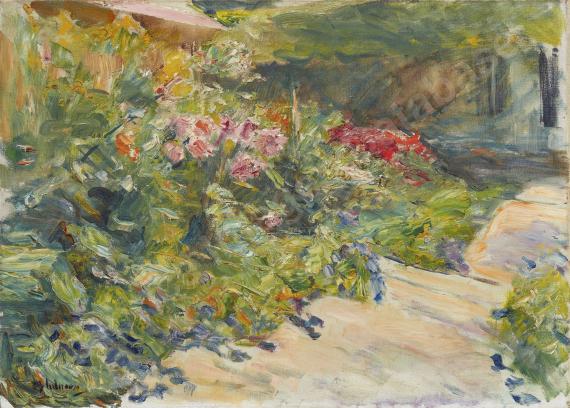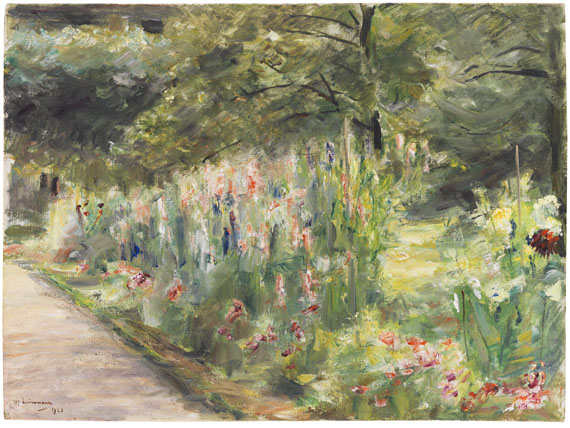Sale: 550 / Evening Sale, June 07. 2024 in Munich  Lot 123001595
Lot 123001595
 Lot 123001595
Lot 123001595
123001595
Max Liebermann
Wannseegarten - Haus mit roten Stauden, 1926.
Oil on canvas
Estimate:
€ 400,000 - 600,000
$ 428,000 - 642,000
Information on buyer's premium, taxation and resale right compensation will be available four weeks before the auction.
Wannseegarten - Haus mit roten Stauden. 1926.
Oil on canvas.
Signed in lower left. 54 x 76 cm (21.2 x 29.9 in).
[JS].
• The famous garden paintings made at his Wannsee mansion are documents of Liebermann's liberation of form and color.
• The play of shadows and sunspots enhances the summer atmosphere of the blossoming garden.
• Wannsee paintings of this intensity are extremely rare on the auction market.
• The vital style and radiant colors make the garden paintings from the 1920s highlights of Liebermann's oeuvre.
We are grateful to Dr. Mara Wantuch-Thole, LL.M. and Dr. Ewald Volhard, as well as the heirs of Hedwig and Jacob Goldschmidt, for their kind support and the transparent expert advice they provided.
PROVENANCE: Galerie Paul Cassirer, Berlin (1926, with the handwritten label and the inventory number “5093” on the stretcher, according to the inventory list, purchased from Liebermann on August 20, 1926 and sold to the following on August 23, 1926).
M. Goldschmidt & Co, Frankfurt a. Main (acquired from the above in 1926).
Karl Haberstock, Berlin.
Collection of Privy Councillor Dr. Karl Beheim, Berlin (from the above before 1931).
Estate of the above (Erika Wolff-Beheim, until (before) 1958).
J. P. Schneider jr, Frankfurt a. Main (from the above around 1958).
Private collection Germany (acquired from the above in 1958, ever since family-owned).
"Liebermann did not discover the garden as a motif any earlier than 1908, spending his summer vacation in the Dutch seaside resort of Noordwijk at the age of sixty. [..] During the war about eight years later, his garden in Wannsee became a central motif in Liebermann's creative work."
Prof. Dr. Matthias Eberle, 2016.
Oil on canvas.
Signed in lower left. 54 x 76 cm (21.2 x 29.9 in).
[JS].
• The famous garden paintings made at his Wannsee mansion are documents of Liebermann's liberation of form and color.
• The play of shadows and sunspots enhances the summer atmosphere of the blossoming garden.
• Wannsee paintings of this intensity are extremely rare on the auction market.
• The vital style and radiant colors make the garden paintings from the 1920s highlights of Liebermann's oeuvre.
We are grateful to Dr. Mara Wantuch-Thole, LL.M. and Dr. Ewald Volhard, as well as the heirs of Hedwig and Jacob Goldschmidt, for their kind support and the transparent expert advice they provided.
PROVENANCE: Galerie Paul Cassirer, Berlin (1926, with the handwritten label and the inventory number “5093” on the stretcher, according to the inventory list, purchased from Liebermann on August 20, 1926 and sold to the following on August 23, 1926).
M. Goldschmidt & Co, Frankfurt a. Main (acquired from the above in 1926).
Karl Haberstock, Berlin.
Collection of Privy Councillor Dr. Karl Beheim, Berlin (from the above before 1931).
Estate of the above (Erika Wolff-Beheim, until (before) 1958).
J. P. Schneider jr, Frankfurt a. Main (from the above around 1958).
Private collection Germany (acquired from the above in 1958, ever since family-owned).
"Liebermann did not discover the garden as a motif any earlier than 1908, spending his summer vacation in the Dutch seaside resort of Noordwijk at the age of sixty. [..] During the war about eight years later, his garden in Wannsee became a central motif in Liebermann's creative work."
Prof. Dr. Matthias Eberle, 2016.
Max Liebermann was able to acquire one of the last waterfront plots in the Alsen villa colony on the banks of the 'Großer Wannsee' in 1909. He then commissioned the architect Paul Baumgarten to build a two-story country house in the style of Hamburg Classicism amid the elongated plot. He discussed the garden's layout with his friend Alfred Lichtwark, the director of the Kunsthalle in Hamburg, to whom he had just sold the portrait of the poet Richard Dehmel. Extensive correspondence between the artist, his daughter Käthe, and the art historian bears witness to the museum man's intensive study of historical gardens, taking the needs of the painter and his family into account. After the painter had asked him for assistance with the garden in a letter, Lichtwark and Liebermann went to Wannsee in November 1909.
"Dear Professor, thank you very much for your kind letters. It is truly very kind of you to take so much interest in our garden. Mr. Brodersen [Albert Brodersen, garden architect] is away at the moment, but as soon as he returns, we will send for him and revise the garden plan taking your letters into account. Once the new plans are ready, you must allow me to send them to you.
Your most sincerely devoted Käthe Liebermann" (Berlin, December 26, 1909, quoted from Birgit Pflugmacher, Max Liebermann - sein Briefwechsel mit Alfred Lichtwark, PhD thesis. Hamburg 2001, p. 284)
In addition to his home and studio on Pariser Platz in the heart of Berlin, Liebermann found an ideal rural retreat between Berlin and Potsdam inspired by Goethe's garden house in Weimar. In front of the house facing the street with a small gardener's cottage (today the museum's ticket office), Liebermann had a kitchen garden with tall flowering shrubs laid out in the style of North German country gardens. In paintings depicting this part of the garden, as in the present work, Liebermann captured the wild splendor and lavish abundance of the flowers and transferred them into almost abstract worlds of color and form. The plot behind the house towards the water is dominated by lawns alternating with 'point de vue' hedge beds and birch trees. The scores of paintings Liebermann henceforth made of the garden show it in different layouts and, in addition to their vibrant beauty, are also a document of a past state that has only been partly reconstructed today.
After the house and garden had been completed, Lichtwark met Liebermann in Berlin to survey the results of their exchange. Lichtwark described his impressions in a letter to the board of the Kunsthalle in Hamburg on October 19, 1910: "I am very pleased that it turned out so well. We did not harm the site in any way, but merely sought the obvious results. It was a great pleasure to see them so happy. I had the impression that having so many flowers and home-grown cabbage made them even more gracious and kind." (Quoted from: Petra Wandrey, Zu Besuch bei Max Liebermann am Wannsee, Berlin 2010, p. 67)
After World War I had broken out, Liebermann was no longer able to go on his annual painting trips to Holland. The villa on Wannsee and the garden designed after the garden reformers became a unique source of inspiration for Liebermann. For more than two decades, Liebermann painted his Wannsee garden in all its magnificent colors. From the very beginning, these works emerged as a new element in his extensive oeuvre alongside the known themes. The more the artist became familiar with the structures of the garden, the order between paths and flowerbeds, and the abundance of the plants, the more free and airy his artistic view of this tranquil place far away from the big city would become. While Liebermann's early garden "portraits" were still characterized by French Impressionism, the artist increasingly liberated himself from the strict order of the garden in the mid-1920s and moved his focus to the side, as he does in this case, depicting the flower beds in front of the garden shed. In doing so, Liebermann not only changed his perspective but also switched to an almost Fauvist palette. Green in green with more or less broad brushstrokes form a framework, merging into an opaque green wall, in front of which lush plants with dark red and orange-yellow flowers stand, staggered across a wide bed, which is slightly cropped on the path leading diagonally to the villa on the right, with a neatly tended edge, giving the whole motif direction and, to a certain extent, "bringing it down to earth": Liebermann makes a section of "untouched" subject to his utmost skill.
This free development of nature seems like a liberation from an academic order, which Liebermann, as a strict juror, also gave a face to over the years. For Liebermann, the Wannseegarten as a studio was a welcome change from his home and studio on Pariser Platz next to the Brandenburg Gate, just opposite the Academy of Fine Arts, where he received guests from society and sometimes painted portraits. The Wannsee garden and the more than one hundred pictures created there are a testimony to the artist's way of getting closer to the wild growth of nature and, with this "portrait" of the flowering shrubs, he has virtually stepped into it. [MvL]
"Dear Professor, thank you very much for your kind letters. It is truly very kind of you to take so much interest in our garden. Mr. Brodersen [Albert Brodersen, garden architect] is away at the moment, but as soon as he returns, we will send for him and revise the garden plan taking your letters into account. Once the new plans are ready, you must allow me to send them to you.
Your most sincerely devoted Käthe Liebermann" (Berlin, December 26, 1909, quoted from Birgit Pflugmacher, Max Liebermann - sein Briefwechsel mit Alfred Lichtwark, PhD thesis. Hamburg 2001, p. 284)
In addition to his home and studio on Pariser Platz in the heart of Berlin, Liebermann found an ideal rural retreat between Berlin and Potsdam inspired by Goethe's garden house in Weimar. In front of the house facing the street with a small gardener's cottage (today the museum's ticket office), Liebermann had a kitchen garden with tall flowering shrubs laid out in the style of North German country gardens. In paintings depicting this part of the garden, as in the present work, Liebermann captured the wild splendor and lavish abundance of the flowers and transferred them into almost abstract worlds of color and form. The plot behind the house towards the water is dominated by lawns alternating with 'point de vue' hedge beds and birch trees. The scores of paintings Liebermann henceforth made of the garden show it in different layouts and, in addition to their vibrant beauty, are also a document of a past state that has only been partly reconstructed today.
After the house and garden had been completed, Lichtwark met Liebermann in Berlin to survey the results of their exchange. Lichtwark described his impressions in a letter to the board of the Kunsthalle in Hamburg on October 19, 1910: "I am very pleased that it turned out so well. We did not harm the site in any way, but merely sought the obvious results. It was a great pleasure to see them so happy. I had the impression that having so many flowers and home-grown cabbage made them even more gracious and kind." (Quoted from: Petra Wandrey, Zu Besuch bei Max Liebermann am Wannsee, Berlin 2010, p. 67)
After World War I had broken out, Liebermann was no longer able to go on his annual painting trips to Holland. The villa on Wannsee and the garden designed after the garden reformers became a unique source of inspiration for Liebermann. For more than two decades, Liebermann painted his Wannsee garden in all its magnificent colors. From the very beginning, these works emerged as a new element in his extensive oeuvre alongside the known themes. The more the artist became familiar with the structures of the garden, the order between paths and flowerbeds, and the abundance of the plants, the more free and airy his artistic view of this tranquil place far away from the big city would become. While Liebermann's early garden "portraits" were still characterized by French Impressionism, the artist increasingly liberated himself from the strict order of the garden in the mid-1920s and moved his focus to the side, as he does in this case, depicting the flower beds in front of the garden shed. In doing so, Liebermann not only changed his perspective but also switched to an almost Fauvist palette. Green in green with more or less broad brushstrokes form a framework, merging into an opaque green wall, in front of which lush plants with dark red and orange-yellow flowers stand, staggered across a wide bed, which is slightly cropped on the path leading diagonally to the villa on the right, with a neatly tended edge, giving the whole motif direction and, to a certain extent, "bringing it down to earth": Liebermann makes a section of "untouched" subject to his utmost skill.
This free development of nature seems like a liberation from an academic order, which Liebermann, as a strict juror, also gave a face to over the years. For Liebermann, the Wannseegarten as a studio was a welcome change from his home and studio on Pariser Platz next to the Brandenburg Gate, just opposite the Academy of Fine Arts, where he received guests from society and sometimes painted portraits. The Wannsee garden and the more than one hundred pictures created there are a testimony to the artist's way of getting closer to the wild growth of nature and, with this "portrait" of the flowering shrubs, he has virtually stepped into it. [MvL]
123001595
Max Liebermann
Wannseegarten - Haus mit roten Stauden, 1926.
Oil on canvas
Estimate:
€ 400,000 - 600,000
$ 428,000 - 642,000
Information on buyer's premium, taxation and resale right compensation will be available four weeks before the auction.




